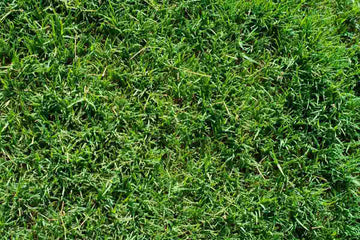Here’s How to Make Your Lawn Look Like a Golf Course
by Jamie Tedder on Feb 06, 2024

The well-manicured appearance of fairway grass provides a picturesque backdrop for golfers and spectators alike. These meticulously maintained golf courses are often featured in postcards and sports magazines, and deservedly so.
It’s not an accident or fair luck that golf courses are kept in such pristine conditions. It requires comprehensive maintenance including proper mowing, fertilization, and disease control. These measures are aimed at maintaining the perfect balance of health, density, texture, and playability that is both visually appealing and conducive to a great golfing experience.
While you may not be aiming for your lawn to be a golf course, you can certainly make it look as green and healthy with these tips.
6 Tips to Create a Golf Course-Looking Lawn
You don’t need a full crew of professionals to landscape your lawn, but you can recreate the look and quality of a golf course starting by investing in a high-quality grass used in this sports field.
1. Use the Right Type of Grass
The choice of grass type often depends on the climate and location of the golf course, as different grasses thrive in different conditions. In the warm, humid climate of Florida, warm-season grass like Bermuda grass is often used for its fine texture, versatility, drought tolerance, and ability to withstand heavy foot traffic and low mowing heights. It is also favored for its dense, lush growth habit that effectively inhibits weed growth.
BIMINI® Bermudagrass is a standout among Bermuda grass varieties, featuring heightened tolerance to heavy traffic, ability to recover from damage, and resilience to extreme weather conditions. It maintains its striking dark green color in harsh temperatures that would usually send other grasses into a dormant state.
2. Level Your Lawn
One of the defining features of golf courses is their smooth surface, which ensures a consistent playing experience. It ensures the ball rolls predictably, allowing players to accurately judge their shots. While your lawn may appear flat at first glance, any bumps or dips become more prominent when the grass is cut shorter.
Top dressing is a great way to create a smoother lawn surface. It involves applying a layer of soil leveling mix, usually a combination of soil, sand, and organic matter like compost or peat moss. This practice can be particularly beneficial prior to sod installation. It facilitates better sod-to-soil contact, improves soil structure, and provides essential nutrients to ensure the successful establishment of the new grass.

3. Mow Frequently
Golf fairways are usually maintained at a height of 0.75 inches, considerably lower than the average lawn mowing height of 2.5 inches to 3 inches. It means grass on golf courses are cut more often, sometimes as often as every day or every other day, to maintain its ideal height. While it may seem counterintuitive, more frequent mowing can actually stimulate the grass to grow thicker, which helps to choke out weeds and fosters denser growth.
So, how often should you mow? Follow the one-third rule: never trim more than one-third of the grass blades in a single mowing to avoid scalping or causing shock to the grass. You can space out your mowing sessions to once every three days to once a week as long as the grass is dry and the weather is cool.
4. Upgrade Your Lawn Mower
There are different types of lawn mowers today, but if you want your lawn to look like the grass at a country club, a reel mower is a great option. Unlike rotary mowers, reel mowers perform better at lower mowing heights, even as short as under an inch.
They provide a more precise cut, similar to using a sharp pair of scissors. When the blades are sharp, reel mowers cut the grass cleanly, reducing the risks of lawn diseases that can occur when grass blades are torn or jagged.
5. Water Less Often But More Deeply
Watering your lawn takes the opposite approach to mowing — less frequently but more deeply. For warm-season grass varieties like BIMINI® Bermuda, it usually means providing about 1 to 1.5 inches of water weekly, including rainfall.
Deep watering encourages stronger and deeper root development than shallow, frequent watering. These deeper roots make your lawn more drought-resistant, leading to overall better lawn health.

6. Fertilize Properly
Any grass, whether on lawns or golf courses, benefits from a balanced lawn fertilizer containing nitrogen, phosphorus, and potassium, which are the essential macronutrients for healthy growth. Nitrogen stimulates top growth, phosphorus supports root development, while potassium strengthens the grass, improving its resistance to drought and disease.
However, it's important to tailor your fertilizer approach to the specific needs of your lawn. A soil test can provide valuable information about the nutrient levels in your soil, allowing you to make informed decisions about the type and amount of fertilizer to apply. By analyzing your soil, you can create an optimal environment for healthy grass growth and reduce the risk of over- or under-fertilization.

BIMINI® Bermuda — A Versatile Option for Golf Courses and Residential Lawns
BIMINI® Bermuda is a versatile grass variety that finds extensive use in golf courses, sports fields, as well as residential and commercial landscapes. Its recent installation at Panther National golf course in Palm Beach highlights its suitability for elevating fairways and providing a lush, durable surface for high-traffic areas.
Other than its adaptability, BIMINI® delivers aesthetic appeal with its beautiful dark green color and fine-textured leaves that feel soft underfoot. Its rapid spreading growth habit allows for faster establishment and recovery, making it ideal for areas subjected to wear and tear. Additionally, BIMINI® Bermuda exhibits remarkable weather tolerance, able to withstand prolonged dry spells and retain its vibrant color longer than other varieties in harsh conditions. Its ability to thrive in various soil conditions further enhance its appeal, making it a resilient option for various applications.
Did you find this article helpful? Share your thoughts by leaving a comment.




